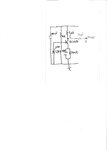visions_of_eden
Newbie level 5
Hi,
i have a problem with a simple 30.875Mhz (garage opener) crystal oscillator .
The problem is that the frequency it generates is not the expected one . On the attached schematics , if i measure the frequency using a frequency counter on "A" point i get 30.876Mhz which is correct , but on the other side of the 27pF capacitor at "B" only get 20.606Mhz .
My crystal is a 3rd overtone crystal , is it possible that it's oscillating at 2nd overtone frequency ? Why do i get a lower frequency on the capacitor ?
The output of my oscillator will be fed into a ASK modulator , so the capacitor is only needed to cut DC offset from next modulator stage . Why does it cut the frequency ?
Maybe the oscillator has not a good stability ? What sould i check ?
I don't have expericence with oscillators , so sorry if my questions looks stupid .
Thansk in advance .
Nicola .
i have a problem with a simple 30.875Mhz (garage opener) crystal oscillator .
The problem is that the frequency it generates is not the expected one . On the attached schematics , if i measure the frequency using a frequency counter on "A" point i get 30.876Mhz which is correct , but on the other side of the 27pF capacitor at "B" only get 20.606Mhz .
My crystal is a 3rd overtone crystal , is it possible that it's oscillating at 2nd overtone frequency ? Why do i get a lower frequency on the capacitor ?
The output of my oscillator will be fed into a ASK modulator , so the capacitor is only needed to cut DC offset from next modulator stage . Why does it cut the frequency ?
Maybe the oscillator has not a good stability ? What sould i check ?
I don't have expericence with oscillators , so sorry if my questions looks stupid .
Thansk in advance .
Nicola .

